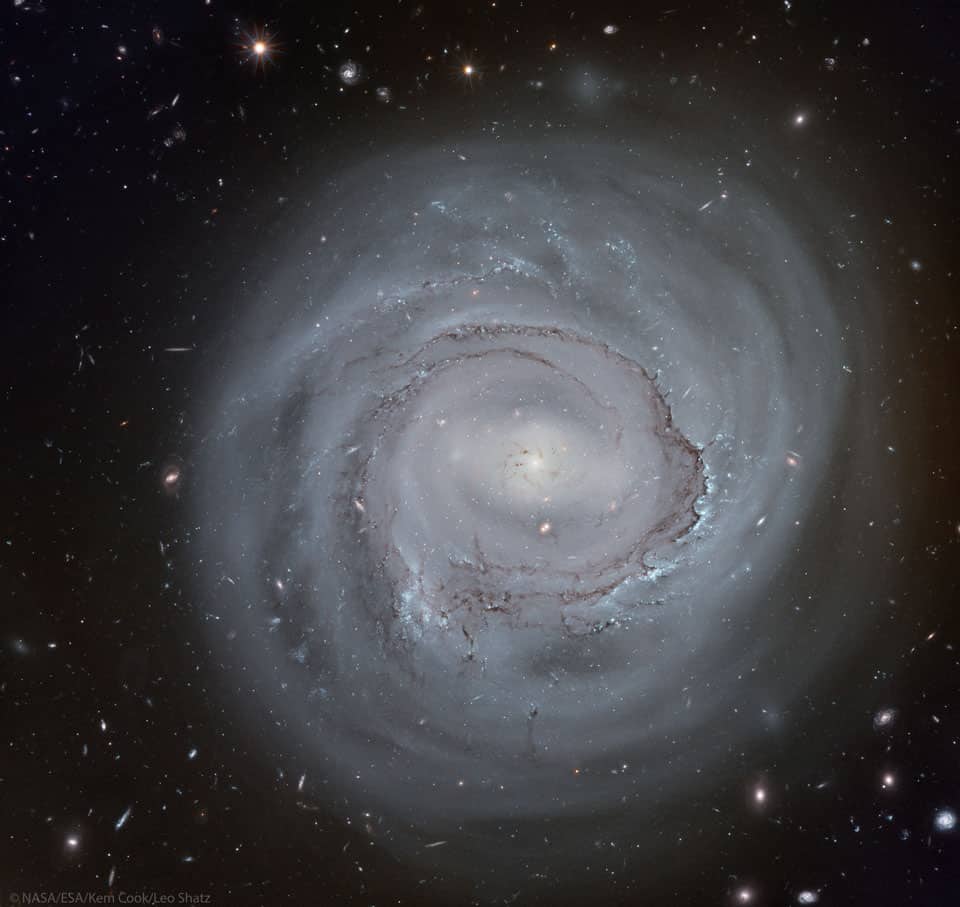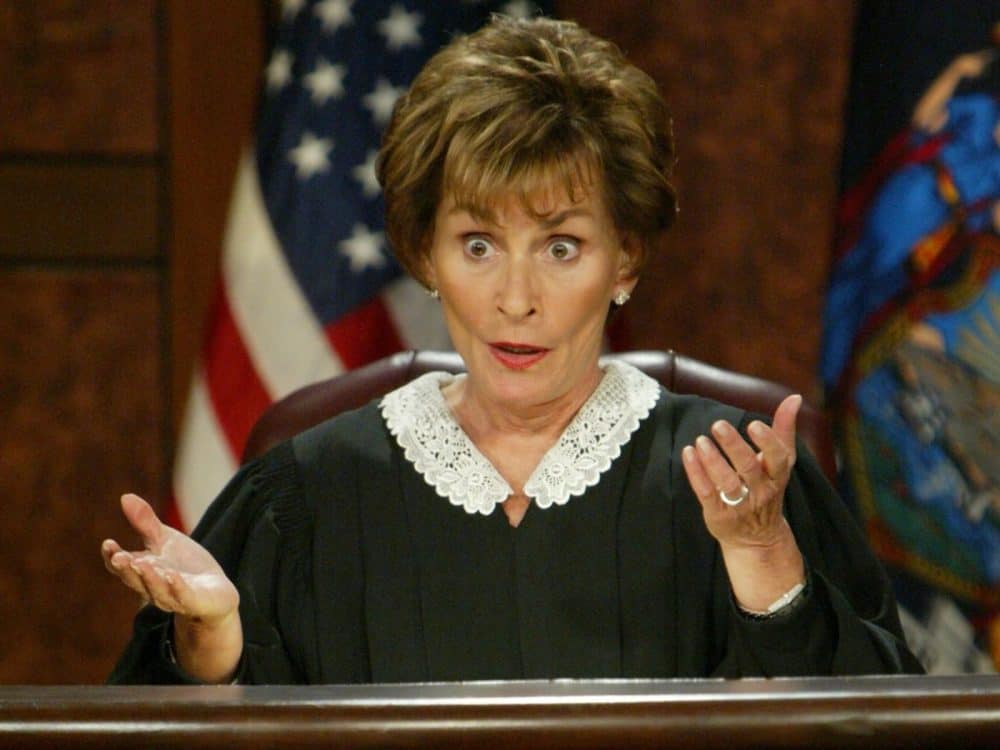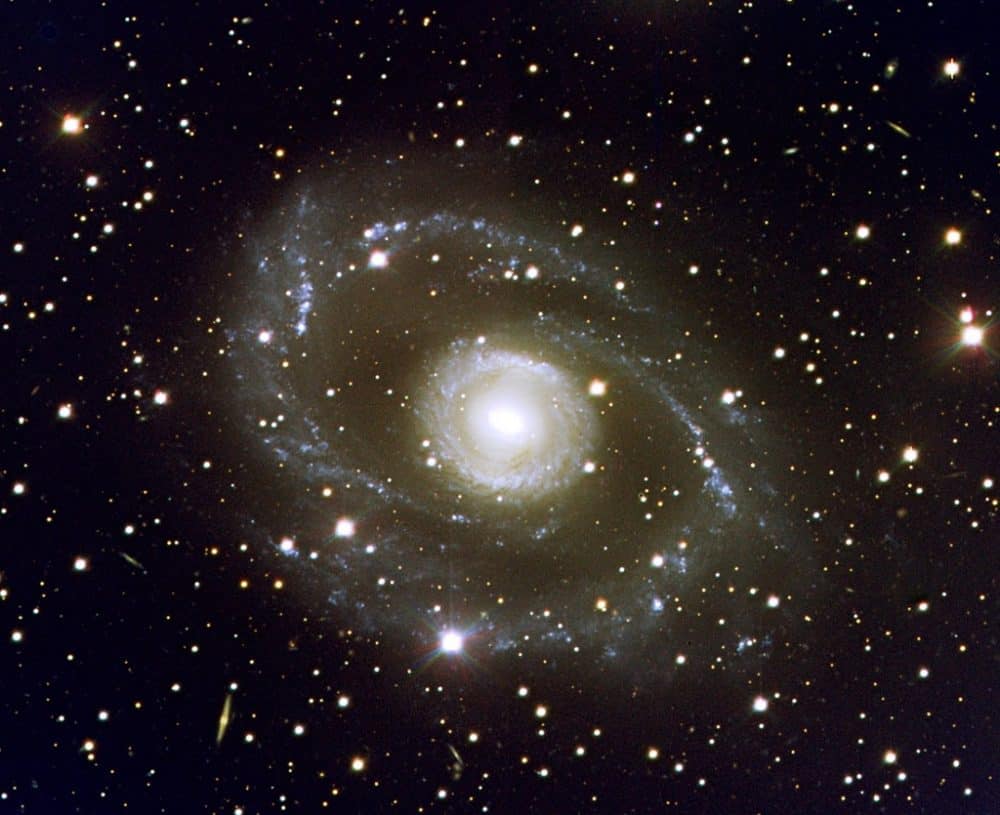Blog
Let’s go Viral! It’s on YouTube now at 35:40 or the last 8 minutes approx.
https://youtu.be/dbD74u63v_0?fbclid=IwAR3TmLdWqsWUp4sQ9M3E5lqYw4Gt9PeyyMBi2YW-zyseepjeQdE5BLH1uNc
more...Although presently estimated to be about 300 million light years distant, a more precise determination could be coupled with its known recession speed to help humanity better calibrate the expansion rate of the entire visible universe. Toward this goal, several images were taken by the Hubble Space Telescope in order to help identify key stellar distance markers known as Cepheid variable stars. Since NGC 4921 is a member of the Coma Cluster of Galaxies, refining its distance would also allow a better distance determination to one of the largest nearby clusters in the local universe. The magnificent spiral NGC 4921 has been informally dubbed anemic because of its low rate of star formation and low surface brightness. Visible in the featured image are, from the center, a bright nucleus, a bright central bar, a prominent ring of dark dust, blue clusters of recently formed stars, several smaller companion galaxies, unrelated galaxies in the far distant universe, and unrelated stars in our Milky Way Galaxy.
more...Brian Peter George St John le Baptiste de la Salle Eno, RDI (/ˈiːnoʊ/; born Brian Peter George Eno, 15 May 1948) is an English musician, record producer, and visual artist best known for his pioneering work in ambient music and contributions to rock, pop, electronic, and generative music. A self-described “non-musician”, Eno has helped introduce a variety of conceptual approaches and recording techniques to contemporary music, advocating a methodology of “theory over practice, serendipity over forethought, and texture over craft” according to AllMusic. He has been described as one of popular music‘s most influential and innovative figures.
Born in Suffolk, Eno studied painting and experimental music at the art school of Ipswich Civic College in the mid 1960s, and then at Winchester School of Art. He joined glam rock group Roxy Music as synthesiser player in 1971. After recording two albums with Roxy Music, he departed in 1973 to record a number of solo albums, coining the term “ambient music” to describe his work on releases such as Another Green World (1975), Discreet Music (1975), and Music for Airports (1978). He also collaborated with artists such as Robert Fripp, Cluster, Harold Budd, David Bowie on his “Berlin Trilogy“, and David Byrne, and produced albums by artists including John Cale, Jon Hassell, Laraaji, Talking Heads and Devo, and the no wave compilation No New York (1978).
Eno has continued to record solo albums and work with artists including U2, Laurie Anderson, Grace Jones, Slowdive, Coldplay, James Blake, and Damon Albarn. Dating back to his time as a student, he has also worked in media including sound installations and his mid-70s co-development of Oblique Strategies, a deck of cards featuring cryptic aphorisms intended to spur creative thinking. From the 1970s onwards, Eno’s installations have included the sails of the Sydney Opera House in 2009 and the Lovell Telescope at Jodrell Bank in 2016. An advocate of a range of humanitarian causes, Eno writes on a variety of subjects and is a founding member of the Long Now Foundation. In 2019, Eno was inducted into the Rock and Roll Hall of Fameas a member of Roxy Music.
https://www.youtube.com/watch?v=-dikWB6wm0A
more...Ellis Larkins (May 15, 1923 – September 30, 2002) was an American jazz pianist born in Baltimore, Maryland, perhaps best known for his two recordings with Ella Fitzgerald: the albums Ella Sings Gershwin (1950) and Songs in a Mellow Mood (1954).[1] He was also the leader in the first solo sides by singer Chris Connor on her album Chris (1954).
Larkins was the first African American to attend the Peabody Conservatory of Music, a well-known institute in Baltimore. He began his professional playing career in New York City after moving there to attend the Juilliard School. Following school Larkins performed jazz piano with Billy Moore and Edmond Hall. He recorded with Coleman Hawkins, Mildred Bailey, and Dicky Wells in the 1940s. In the 1950s he recorded with Ella Fitzgerald, Ruby Braff, and Beverly Kenney. His 1960s work included recordings or performances with Eartha Kitt, Joe Williams, Helen Humes, Georgia Gibbs and Harry Belafonte.
Though he was best known as an accompanist, Larkins recorded several solo albums in the 1950s. In the 1970s he performed regularly at several New York venues, including Gregory’s, a small bar on the Upper East Side.
more...ESO 269-G57 is a huge barred spiral galaxy of nearly 200,000 light-years across (almost twice as large as our Milky Way galaxy!), located some 155 million light-years away towards the southern constellation of Centaurus (the Centaur), in the center of the Centaurus cluster of galaxies. It is speeding away from us at roughly 3110 kilometers per second.
This galaxy was discovered during the ESO/Uppsala Survey of the Southern Skies in the 1970s, during which over 15,000 southern galaxies were found.
This symmetrical starburst galaxy shows us its central galactic nucleus (yellow), surrounded by an inner ring of tightly wound spiral arms. Spiralling out from this are two more diffuse spiral arms that appear to split into several branches. The spiral arms and the inner ring contain many star-forming regions (blue). ESO 269-G57 consists of about 300 billion stars and 270 billion multiple star systems.
In 1992 supernova 1992K was observed in this galaxy, south-west of its nucleus.
The data for this image were obtained with the Very Large Telescope using several filters on the ANTU and FORS1 instruments on 27 March 1999, and further processed by Henri Boffin (ESO). The image includes many foreground stars and distant background galaxies. North is up and East is to the left.
more...John Symon Asher Bruce (14 May 1943 – 25 October 2014) was a Scottish musician, singer and songwriter known primarily for his contributions to the British supergroup Cream, which also included the guitarist-singer Eric Clapton and the drummer Ginger Baker. In March 2011 Rolling Stone readers selected him as the eighth greatest bass guitarist of all time. “Most musicians would have a very hard time distinguishing themselves if they wound up in a band with Eric Clapton and Ginger Baker,” the magazine said at the time, “but Jack Bruce was so gifted on the bass that he did it with ease.”
Bruce maintained a solo career that spanned several decades and also played in several musical groups. Although recognized first and foremost as a vocalist, bassist and songwriter, he also played double bass, harmonica, piano, cello and guitar. He was trained as a classical cellist and considered himself a jazz musician, although much of his catalogue of compositions and recordings tended toward rock and blues.
more...Sidney Bechet (May 14, 1897 – May 14, 1959) was an American jazz saxophonist, clarinetist, and composer. He was one of the first important soloists in jazz, beating trumpeter Louis Armstrong to the recording studio by several months. His erratic temperament hampered his career, and not until the late 1940s did he earn wide acclaim.
Bechet was born in New Orleans in 1897 to a middle-class Creole of color family. His older brother, Leonard Victor Bechet, was a full-time dentist and a part-time trombonist and bandleader. Bechet learned several musical instruments that were kept around the house, mostly by teaching himself; he decided to specialize in the clarinet. At the age of six, he started playing with his brother’s band at a family birthday party, debuting his talents to acclaim. Later in his youth, Bechet studied with Lorenzo Tio, “Big Eye” Louis Nelson Delisle, and George Baquet.
Bechet played in many New Orleans ensembles using the improvisational techniques of the time (obbligatos with scales and arpeggios and varying the melody). He performed in parades with Freddie Keppard‘s brass band, the Olympia Orchestra, and in John Robichaux‘s dance orchestra. From 1911 to 1912, he performed with Bunk Johnson in the Eagle Band of New Orleans and in 1913–14 with King Oliver in the Olympia Band. From 1914 to 1917 he was touring and traveling, going as far north as Chicago and frequently performing with Freddie Keppard. In the spring of 1919, he traveled to New York City where he joined Will Marion Cook‘s Syncopated Orchestra. Soon after, the orchestra traveled to Europe; almost immediately upon arrival, they performed at the Royal Philharmonic Hall in London. The group was warmly received, and Bechet was especially popular. While in London, he discovered the straight soprano saxophone and developed a style unlike his clarinet tone. His saxophone sound could be described as emotional, reckless, and large. He often used a broad vibrato, similar to what was common among some New Orleans clarinetists at the time. On July 30, 1923, he began recording. The session was led by Clarence Williams, a pianist and songwriter, better known at that time for his music publishing and record producing. Bechet recorded “Wild Cat Blues” and “Kansas City Man Blues”. “Wild Cat Blues” is in a ragtime style with four 16-bar themes, and “Kansas City Man Blues” is a 12-bar blues.
more...https://www.youtube.com/watch?v=34OwiSJXBTI
more...Judge Judy & the incomparable prankster himself the mickster, airing tomorrow Tuesday May 14th 2019 coast to coast. Hold on to your Jurisprudence kids its way over the top and more! I’m shocked they are airing this one probably with edits???
S23 E199 season 23 episode 199
“Where There’s Smoke … There’s More Smoke!” NEW!
In Minneapolis its the 430pm slot, there is also a 4pm show. So apparently Judge Judy is aired twice daily on nationwide networks. Look for S23 E199 and bingo thats it! It is listed on the internet. LETS GO VIRAL! Record and post to youtube! LOL
The colorful clouds surrounding the star system Rho Ophiuchi compose one of the closest star forming regions. Rho Ophiuchi itself is a binary star system visible in the blue reflection nebula just to the left of the image center. The star system, located only 400 light years away, is distinguished by its multi-colored surroundings, which include a red emission nebula and numerous light and dark brown dust lanes. Near the lower left of the Rho Ophiuchi molecular cloud system is the yellow star Antares, while a distant but coincidently-superposed globular cluster of stars, M4, is visible just to the right of Antares. Near the image top lies IC 4592, the Blue Horsehead nebula. The blue glow that surrounds the Blue Horsehead’s eye — and other stars around the image — is a reflection nebula composed of fine dust. On the featured image right is a geometrically angled reflection nebula cataloged as Sharpless 1. Here, the bright star near the dust vortex creates the light of surrounding reflection nebula. Although most of these features are visible through a small telescope pointed toward the constellations of Ophiuchus, Scorpius, and Sagittarius, the only way to see the intricate details of the dust swirls, as featured above, is to use a long exposure camera.
more...Stevland Hardaway Morris (né Judkins; born May 13, 1950), better known by his stage name Stevie Wonder, is an American singer, songwriter, musician, record producer, and multi-instrumentalist.
A child prodigy, Wonder is considered to be one of the most critically and commercially successful musical performers of the late 20th century. He signed with Motown‘s Tamla label at the age of 11, and continued performing and recording for Motown into the 2010s. He has been blind since shortly after his birth. Among Wonder’s works are singles such as “Signed, Sealed, Delivered I’m Yours“, “Superstition“, “Sir Duke“, “You Are the Sunshine of My Life“, and “I Just Called to Say I Love You“; and albums such as Talking Book (1972), Innervisions(1973), and Songs in the Key of Life (1976). He has recorded more than 30 U.S. top-ten hits and received 25 Grammy Awards, one of the most-awarded male solo artists, and has sold more than 100 million records worldwide, making him one of the top 60 best-selling music artists.
Wonder is also noted for his work as an activist for political causes, including his 1980 campaign to make Martin Luther King Jr.‘s birthday a holiday in the United States. In 2009, Wonder was named a United Nations Messenger of Peace. In 2013, Billboard magazine released a list of the Billboard Hot 100 All-Time Top Artists to celebrate the US singles chart’s 55th anniversary, with Wonder at number six.
more...William McKinley “Red” Garland, Jr. (May 13, 1923 – April 23, 1984) was an American modern jazz pianist. Known for his work as a bandleader and during the 1950s with Miles Davis, Garland helped popularize the block chord style of piano playing. William “Red” Garland was born in 1923 in Dallas, Texas. He began his musical studies on the clarinet and alto saxophone but, in 1941, switched to the piano. Less than five years later, Garland joined the trumpet player Hot Lips Page, well-known in the southwest, playing with him until a tour ended in New York in March 1946. Having decided to stay in New York to find work, Art Blakey came across Garland playing at a small club, only to return the next night with Blakey’s boss, Billy Eckstine.
Garland also had a short-lived career as a welterweight boxer in the 1940s. He fought more than 35 fights, one being an exhibition bout with Sugar Ray Robinson. Garland became famous in 1954 when he joined the Miles Davis Quintet, featuring John Coltrane, Philly Joe Jones, and Paul Chambers. Davis was a fan of boxing and was impressed that Garland had boxed earlier in his life. Together, the group recorded their famous Prestige albums, Miles: The New Miles Davis Quintet (1954), Workin, Steamin’, Cookin’, and Relaxin’. Garland’s style is prominent in these seminal recordings—evident in his distinctive chord voicings, his sophisticated accompaniment, and his musical references to Ahmad Jamal’s style. Some observers dismissed Garland as a “cocktail” pianist, but Miles was pleased with his style, having urged Garland to absorb some of Jamal’s lightness of touch and harmonics within his own approach.
more...Ian Ernest Gilmore Evans (born Green; May 13, 1912 – March 20, 1988) was a Canadian jazz pianist, arranger, composer and bandleader. He is widely recognized as one of the greatest orchestrators in jazz, playing an important role in the development of cool jazz, modal jazz, free jazz, and jazz fusion. He is best known for his acclaimed collaborations with Miles Davis.
https://www.youtube.com/watch?v=xAVzB2ifVZo
more...More Posts
- The Cosmos with IC 1805
- Ernie Watts
- Frank Hewitt
- Gary McFarland
- Sonny Criss
- World Music with Eric Wainaina and Vini Ngugi
- Daily Roots with Jacob Miller
- The Cozmos with M1
- Leslie West
- Clare Fischer
- Candido Camero
- Franz Liszt
- Flamenco Fridays with Jeros, Pepe Habichuela, Montse Cortés, Marina Heredia, Tomasito, Pepe Luis Carmona, Jose Soto Barea, Duquende, Los Chichos
- Daily Roots with Bongo Pat
- The Cozmos with Sh2-308
- Elvin Bishop
- Manfred Mann
- Celia Cruz
- Dizzy Gillespie
- Don Byas





